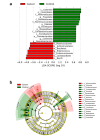Characterisation of gut microbiota in Malaysian cancer patients using V3-V4 region of 16S rRNA gene sequencing
- PMID: 40596568
- PMCID: PMC12216863
- DOI: 10.1038/s41598-025-06983-x
Characterisation of gut microbiota in Malaysian cancer patients using V3-V4 region of 16S rRNA gene sequencing
Abstract
Recent studies suggested a potential connection between gut microbiota changes and cancer onset. However, conflicting results make it challenging to understand the role of gut microbiota dysbiosis in cancer, particularly in underrepresented populations like those in Southeast Asia. To address this gap, we analysed the diversity and composition of gut microbiota in 65 faecal samples, which included 48 from cancer patients with various malignancies and 17 from healthy controls. Patients were categorised into four groups: symptomatic patients undergoing cancer treatment, asymptomatic pre-treatment and during cancer treatment, and healthy controls. Genomic DNA was extracted, and the V3-V4 region of the 16 S rRNA gene was sequenced. Our findings revealed significant differences in the alpha diversity (p ≤ 0.05) between cancer patients and controls. Asymptomatic patients under treatment showed slightly lower alpha diversity than pre-treatment patients, but this difference was not statistically significant (p = 0.06). We identified 13 genera with over 20% difference in abundance between patient groups and controls. Asymptomatic patients receiving treatment and pre-treatment patients exhibited enrichment in Enterococcus, whereas Prevotella, Faecalibacterium, Brevundimonas, and Pseudomonas were significantly reduced compared to controls. Symptomatic patients had higher levels of Enterococcus and Staphylococcus, while Ruminococcus was enriched in asymptomatic patients. These underscore the distinct differences in gut microbiota composition between cancer patients and healthy individuals, particularly in symptomatic cases with potential biomarkers such as Enterococcus, Prevotella, and Faecalibacterium. Our study suggests that cancer treatment may not significantly alter the gut profile of cancer patients. Further research is needed to comprehend the implications of these findings fully.
Keywords: 16S rRNA sequencing; Cancer; Gut microbiota; Hypervariable V3-V4; Malaysia; Symptomatic and asymptomatic cancer patients.
© 2025. The Author(s).
Conflict of interest statement
Declarations. Competing interests: The authors declare no competing interests.
Figures






Similar articles
-
Multiple perinatal characteristics affect the association between maternal diabetes status and early neonatal gut microbiota.mSphere. 2025 Jun 25;10(6):e0091424. doi: 10.1128/msphere.00914-24. Epub 2025 May 16. mSphere. 2025. PMID: 40377305 Free PMC article.
-
[Relationship Between Different Traditional Chinese Medicine Syndrome Types and Gut Microbiota in Patients With Type 2 Diabetes Mellitus].Sichuan Da Xue Xue Bao Yi Xue Ban. 2025 Mar 20;56(2):389-399. doi: 10.12182/20250360507. Sichuan Da Xue Xue Bao Yi Xue Ban. 2025. PMID: 40599291 Free PMC article. Chinese.
-
Association of gut microbiota with overweight/obesity combined with gestational diabetes mellitus.J Med Microbiol. 2025 May;74(5):002010. doi: 10.1099/jmm.0.002010. J Med Microbiol. 2025. PMID: 40366751 Free PMC article.
-
Intravenous magnesium sulphate and sotalol for prevention of atrial fibrillation after coronary artery bypass surgery: a systematic review and economic evaluation.Health Technol Assess. 2008 Jun;12(28):iii-iv, ix-95. doi: 10.3310/hta12280. Health Technol Assess. 2008. PMID: 18547499
-
Impact of residual disease as a prognostic factor for survival in women with advanced epithelial ovarian cancer after primary surgery.Cochrane Database Syst Rev. 2022 Sep 26;9(9):CD015048. doi: 10.1002/14651858.CD015048.pub2. Cochrane Database Syst Rev. 2022. PMID: 36161421 Free PMC article.
References
-
- Fan, Y. & Pedersen, O. Gut microbiota in human metabolic health and disease. Nat. Rev. Microbiol.19, 55–71. 10.1038/s41579-020-0433-9 (2021). - PubMed
-
- Gomaa, E. Z. Human gut microbiota/microbiome in health and diseases: a review. Antonie Van Leeuwenhoek. 113, 2019–2040. 10.1007/s10482-020-01474-7 (2020). - PubMed
-
- World Health Organization. Global cancer burden growing, amidst mounting need for services. (2024). https://www.who.int/news/item/01-02-2024-global-cancer-burden-growing–am... Accessed 29 Jul 2024.
MeSH terms
Substances
LinkOut - more resources
Full Text Sources
Medical
Miscellaneous

